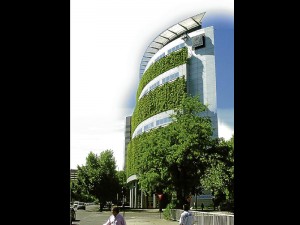The sustainable city in 2050

THE CHEAPEST, easiest and largest reductions in energy demand can be made in buildings. One example is the Consorcio Building in Santiago, Chile by architect Ken Yeang.
WHAT DOES a sustainable world look like? How can we realize it? What are the roles business can play in ensuring more rapid progress toward that world, given the megatrends of climate change, population growth and rapid urbanization?
These are some questions posed by a group of 29 global companies representing 14 industries who collaborated with representatives from business, government and civil society to develop a vision of a sustainable world by 2050.
The group Vision 2050 of the World Business Council for Sustainable Development has set up a platform of dialogue urging us out of our business-as-usual outlook in the present world scenario that requires fundamental changes in governance structures, economic frameworks, business and human behavior.
The business sector is fit to make this call since it is good at innovation, adaptation, collaboration and execution. Vision 2050 studies suggest that changes are necessary, feasible and offer tremendous business opportunities for companies.
Optimistic picture
The project paints an optimistic picture of the future while it seeks to develop and maintain low-carbon, zero-waste cities and infrastructure to improve and manage environmental restoration, lifestyles and livelihoods.
All types of ingenuity will be needed in the next 40 years. Water, food and energy must be managed in a holistic way, as the world insists to embrace a lifestyle of high consumerism.
At the rate our present lifestyle exhausts natural resources, we will need 2.3 planets in 2050 if we fail to undertake drastic changes. The sad state in junk yards and landfills attests to this.
Smarter systems, smarter people, smarter designs and smarter businesses will prevail in 2050. For example, even now smart mobility is shown in Singapore with 5 million people in 700 square kilometers land area; their mass rail transit system has 1.4 million daily ridership.
We have some catching up to do with our 11 million population in 620-sq-km land area in Metro Manila. Our MRT/LRT daily capacity is lower than Singapore’s. We have double the number of buses allowed to ply the Edsa route.
New landscape
The radical new landscape will apply cost-effective creating solutions. New solutions in global and local markets will place new and true values and costs that include external and societal benefits. Accounting reports will include eco-valuation items.
Human development is very critical as survivors will be more flexible, more adept and skillful at responding to rapid changes on all fronts.
Government will have to prioritize long-term stability and progress over short-term benefits.
Tax strategies will give incentives to job creation and healthier products, and discourage environmental damage.
The cheapest, easiest and largest reductions in energy demand can be made in buildings.
Two-thirds of the human population will live in cities in 2050 according to the study. More than half of the people will live in Asia.
One main driver
World population is considered one main driver in the study. At present, half of the world population lives below the replacement level of 2.1 children per woman of reproductive age. Japan, Singapore, South Korea and Thailand belong in that category. In a decade or two, China will see one child supporting two parents and four grandparents.
The country will not be exempt from the birth dearth. In 1960 our total fertility rate was 6.5 children. This dropped to 5 in 1980, and 3 in 2010. They say that we will be down at replacement level by 2025.
For comments or inquiries, e-mail amadodejesus@ gmail.com.

